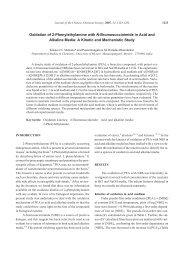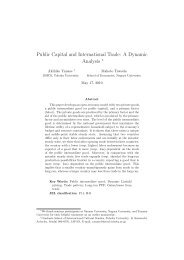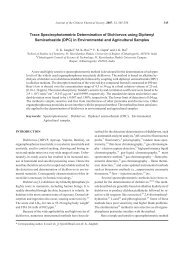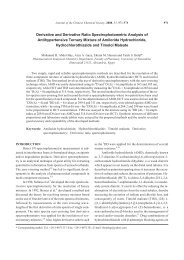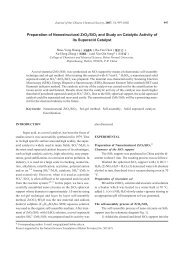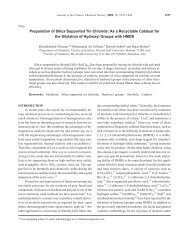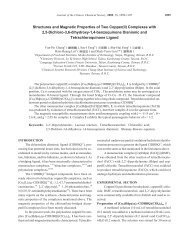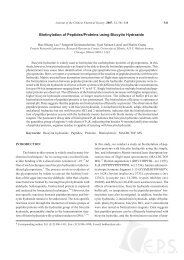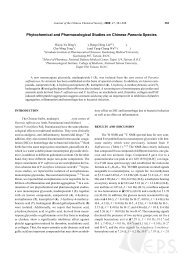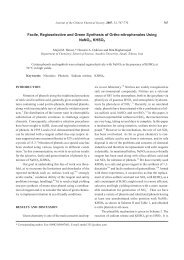Photoinduced Aromatization of Unsymmetrically Substituted 1,4 ...
Photoinduced Aromatization of Unsymmetrically Substituted 1,4 ...
Photoinduced Aromatization of Unsymmetrically Substituted 1,4 ...
Create successful ePaper yourself
Turn your PDF publications into a flip-book with our unique Google optimized e-Paper software.
<strong>Photoinduced</strong> <strong>Aromatization</strong> <strong>of</strong> 1,4-Dihydropyridines J. Chin. Chem. Soc., Vol. 54, No. 1, 2007 133<br />
mechanism for this conversion, in which chlor<strong>of</strong>orm is involved<br />
in the reaction (Scheme II). According to the proposed<br />
mechanism, excited 1,4-dihydropyridine (PyH2*),<br />
especially 1b-1l, donates an electron to chlor<strong>of</strong>orm under<br />
formation <strong>of</strong> PyH2· + and CHCl3· . Elimination <strong>of</strong> HCl from<br />
both intermediates leads to the formation <strong>of</strong> a radical pair,<br />
namely hydropyridyl (PyH·) and dichloromethyl (·CHCl2)<br />
radicals. Hydrogen abstraction by ·CHCl2 radical completes<br />
the reaction by formation <strong>of</strong> the pyridine compound (Py)<br />
and dichloromethane. Other studies also have proposed<br />
this mechanism for the photo-oxidation <strong>of</strong> symmetrical<br />
1,4-dihydropyridines in CCl4 15 and CBrCl3 solutions. 17,20<br />
The interesting point in our study is the expulsion <strong>of</strong><br />
the 4-substituent in the cases <strong>of</strong> 1e, 1k and 1l with a 4-hydroxy-3-methoxyphenyl,<br />
5-methyl-2-furyl and 2-furyl<br />
substituent, respectively, in the 4-position-. The loss <strong>of</strong> the<br />
C-4 substituent upon irradiation <strong>of</strong> Hantzsch esters has<br />
been reported earlier only in the case <strong>of</strong> carboxy groups, 31<br />
some heterocyclic groups, 25 and secondary alkyl and benzyl<br />
groups. 25 The expulsion <strong>of</strong> the 4-substituent has also<br />
been reported upon irradiation <strong>of</strong> diketo-dihydropyridines<br />
with 5-methyl-2-furyl and 2-furyl substituents in the 4 position.<br />
26 Thermal oxidation <strong>of</strong> Hantzsch esters with expulsion<br />
<strong>of</strong> benzylic and secondary alkyl substituents by various<br />
oxidants has also been cited. 26 Most <strong>of</strong> the product derived<br />
from 1d in our work is converted to an unidentified<br />
compound, which stays on the start line when separation is<br />
attempted by PLC and which we considered to be the pyridinium<br />
salt. However, shaking <strong>of</strong> this zone with NaOHsolution<br />
and extraction <strong>of</strong> the aqueous phase with CHCl3<br />
did not give any isolable product.<br />
IR (Table 2), 1 H NMR (Table 3) and UV data (Table<br />
4) gave useful information on the structural assignment <strong>of</strong><br />
Scheme II<br />
Table 2. Comparison <strong>of</strong> the IR spectra I (/cm -1 ) 1a-1l with<br />
those <strong>of</strong> 3a-3j<br />
1 NH CO2C2H5 COCH3 3 CO2C2H5 COCH3 a 3333 1675 1655 a II<br />
1723 1705<br />
b 3289 1700 1645 b 1724 1710<br />
c 3333 1675 1662 c 1724 1688<br />
d 3264 1675 1643 d 1740 1726<br />
e 3291 1677 1640 e 1724 1702<br />
f 3300 1663 1640 f 1724 1700<br />
g 3341 1700 1654 g 1724 1697<br />
h 3290 1692 1648 h 1724 1694<br />
i 3033 1691 1662 i 1724 1705<br />
j 3162 1643 1632 j 1737 1722<br />
k 3307 1691 1646 2 1724 1691<br />
l 3231 1676 1660 2 1724 1691<br />
I<br />
The spectra have been taken as KBr disc, except for 3d which<br />
has been taken in CHCl3-solution. II The absorption at 1551 cm -1<br />
indicated the presence <strong>of</strong> a NO-group.<br />
the photoproducts 2 and 3a-3j.<br />
A comparison <strong>of</strong> the IR spectra showed the disappearance<br />
<strong>of</strong> the NH band and also the shift <strong>of</strong> both CO vibrations<br />
to higher frequency due to the aromatization <strong>of</strong> the<br />
ring, which changes the role <strong>of</strong> the ring from enamine-like<br />
in 1 to acceptor-like in 3. Comparison <strong>of</strong> the 1 H NMR spectra<br />
indicated the loss <strong>of</strong> the signals for NH and also for the<br />
substituent in position 4 because <strong>of</strong> the expulsion <strong>of</strong> this<br />
substituent upon photo-oxidation <strong>of</strong> 1e, 1k and 1l with formation<br />
<strong>of</strong> the identical product 2. In this case, 4-H appears<br />
in the aromatic region at 8.53 ppm. In the 1 H NMR spectra<br />
<strong>of</strong> photoproducts containing the 4-substituent, the loss <strong>of</strong><br />
NH and 4-H resonances was observed. Owing to aromatization<br />
<strong>of</strong> the ring and diminished conjugation <strong>of</strong> the C-C<br />
double bonds with both CO groups, the methyl protons in



